The Dress of All Dresses
The fact that we’re even talking about wedding dresses right now is blowing my mind. Like… what? Me? Wedding dress shopping?! Let the endless scrolls begin! Honestly, I’m so excited to share this with you.
Confession time: I’ve had a Pinterest board titled “Wedding Dresses” since 2012 just in case this moment ever came. So, yeah—it’s been a long time coming. It’s wild how many styles, cuts, shapes, and fabrics there are out there. But at the heart of it, the wedding dress—the wedding dress—has to match you. Your vibe. Your body. Your energy.
Remember the iconic TLC show Say Yes to the Dress? Before I officially say “yes” to my own dress, I want to pause and ask you—why is this dress so important? What makes it such a big deal when getting married? Let’s figure it out together. So grab your coffee and your reading glasses, and let’s dive in.
Quick History 101 of White Wedding Dresses
Source 1: Vogue Everything You Ever Wanted to Know About the White Wedding Dress – Explores the history and evolution of the white wedding dress, highlighting Queen Victoria's influence. written by Maude Bass-Krueger November 13, 2024.
Source 2: Vanity Fair How 20-Year-Old Queen Victoria Forever Changed Wedding Fashion written by Julie Miller April 3, 2018
If you've ever found yourself wondering, “Where did the tradition of white wedding dresses even come from?” and vaguely heard that white symbolizes purity—well, same here. I’ve heard that too. But I couldn’t help thinking, there has to be more to the story than just purity, right? And if you've felt the same way, guess what? We're right. So let’s hop into a time machine and head back to the 1800s.
Back Then, Brides Wore… Whatever
Before the 1800s, brides simply wore the nicest dress they owned—no matter the color. The goal was to look your absolute best on your big day. The color didn’t really matter. Blue, red, black—yes, even black—were all fair game. I even read that wearing black was a Spanish tradition symbolizing the bride’s promise: “Till death do us part.” It was about the commitment.
Then, in 1840, Queen Victoria married Prince Albert wearing a white dress—not because it was tradition or meant to symbolize purity—but because she simply loved the dress. And just like that, history was made.
It’s wild how when you're famous and have that kind of influence, almost anything you wear can set a trend. People saw it, loved it, and soon, white dresses became the thing. Over time, what started as a fashion choice became the norm.
I’m not saying Queen Victoria was the first woman in history to wear a white dress—but she definitely made it iconic and the norm today.
The Style of the Dress: Where to Begin Without Being Overwhelmed
With the help of our good ol’ friend ChatGPT, we’re going to keep things simple. Because let’s be real—getting overwhelmed in the wedding world happens way too quickly and trust me, I am already overwhelmed.
First up, think about what you love and what you think will look good on your body. Wedding dress styles are personal, and there is no one-size-fits-all. Let's break it down by silhouette—the basic shape and structure of the dress.
The Silhouettes- how it will hug your body:
A-line
Ballgown
Mermaid
Sheath (Column)
Tea-length
Fit-and-flare
Trumpet
Empire Waist
If you want to read more in-depth about what each silhouette looks like, here’s a great visual guide:
Silhouette Guide for Wedding Dresses | AW Bridal and/or Wedding Dress Styles: A Guide to Every Silhouette | Brides.com
The Neckline: Let’s Talk “Goodies,” Shoulders & Sexy Backs
Next up—the neckline. How much are we showing? Are we feeling flirty or keeping it modest? Want to highlight your collarbones, shoulders, or go full turtleneck mode? You decide. Each one gives a different energy. You don’t have to show anything you don’t want to. You’re allowed to feel sexy and covered up at the same time. There are so many neckline options:
The sweetheart
V-neck
Off-the-shoulder
Halter
Square
High-neck
Open back
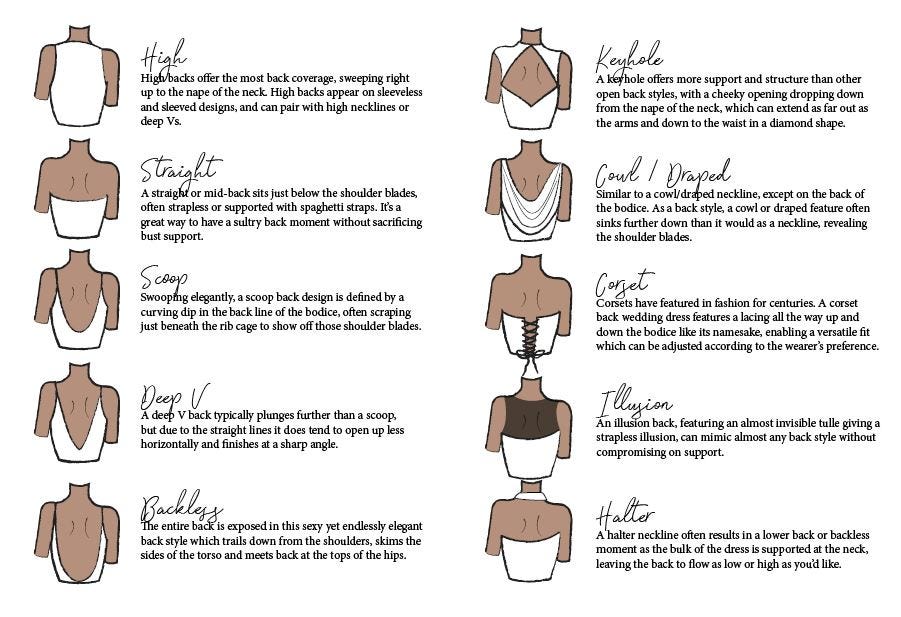
Sleeves & Straps: Fashion Meets Function
Let’s move on to sleeves. Think about the when of your wedding—is it winter? Summer? Destination beach wedding? Indoors with heavy A/C? And then think about what you feel best in.
Here are some of the most common sleeve and strap options:
Strapless
Long-sleeve (so many subtypes here: lace, sheer, fitted, flowy, puffy)
Cap sleeve
Spaghetti strap
Detachable sleeves (we love a 2-in-1 look!)

Fabric Talk: Because Texture Matters
Personally, I love a good lace-and-satin moment. I’ve seen dresses that mix both and I’m obsessed. The texture and weight of your dress will make a huge difference, not only in how it looks but also in how it moves—and how you feel in it.
Here are some common wedding dress fabrics:
Lace
Satin
Tulle
Crepe
Mikado
Chiffon
Check out this helpful fabric guide: Wedding Dress Fabrics and Materials: Guide and Swatches
The Details: Bows, Color, Trains, Slits & More
Now, let’s talk details—because the dress isn’t just about shape and fabric. Are we going trendy with bows? Going bold with color? Maybe you're dreaming of a dramatic cathedral-length train or a sexy leg slit. Maybe you want a veil, or maybe not at all.
Ask yourself:
Do I want color or classic white?
Am I adding bows, floral appliqué, pearls, or sparkle?
How long do I want my train?
Do I want a slit for a little leg moment?
Do I want to keep it simple or go all out?
At the start of writing this blog post, I’ll be honest—I felt overwhelmed. But breaking it down like this has seriously calmed my anxiety by, like, four notches. And while this is far from a complete list of all wedding dress possibilities, it’s a solid starting point.
So here’s what I was thinking: I’ll add some photos from my Pinterest board (yes, the one I’ve been curating for over a decade). Will these dresses look good on me? Honestly, I won’t know until I try them on. But they’re the styles I’m drawn to and excited to explore. Some dresses have details or characteristics that I want to have, like I may like the sleeves, the silhouette or neckline. That’s where customizing comes in—and let’s be honest, that’s where money talks.
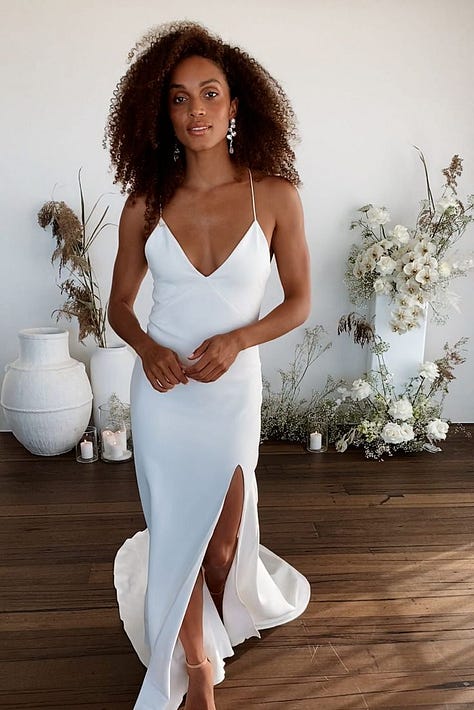
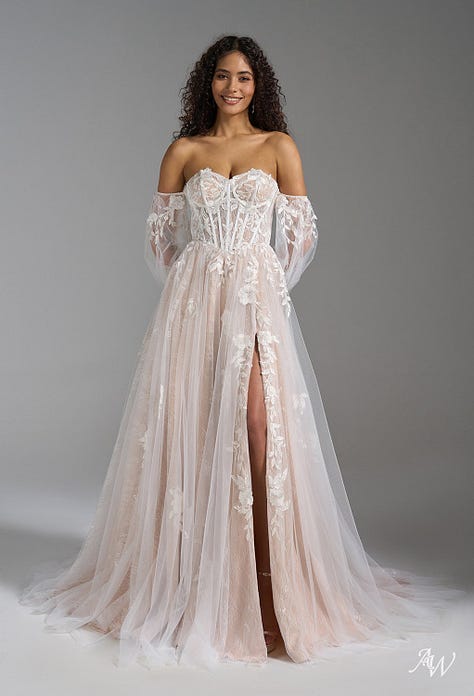

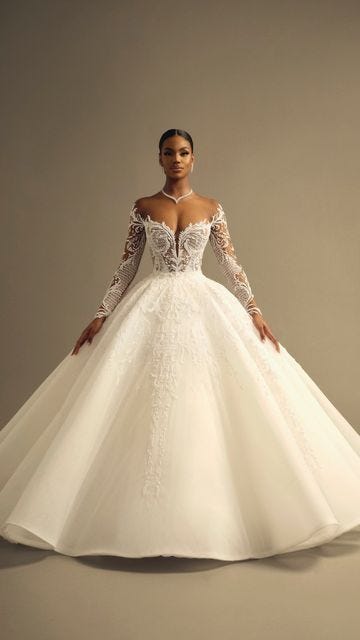
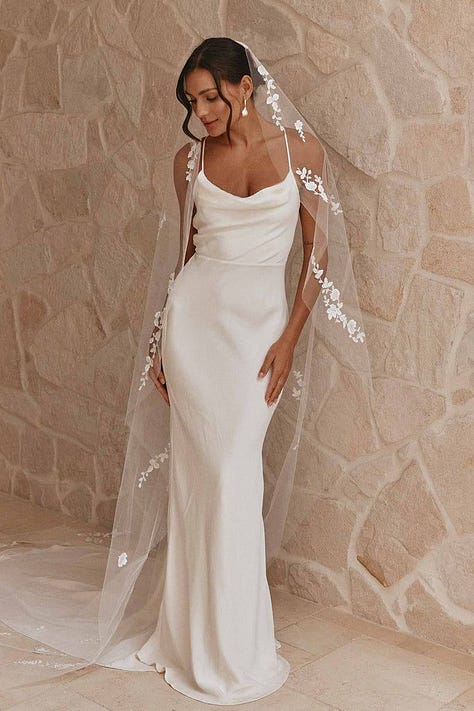
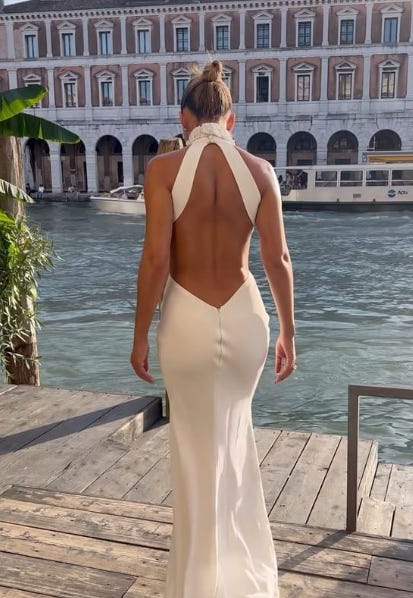

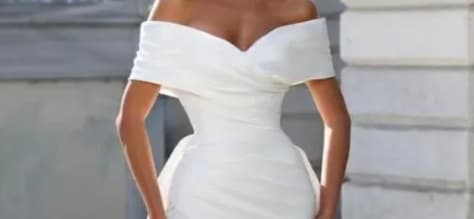
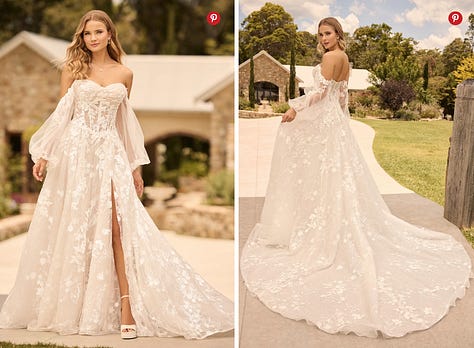
The Big Question: How Much Is Too Much for a Wedding Dress?
Now that we’ve got some inspiration, let’s talk about that one topic no one really wants to bring up: the budget.
What is a reasonable amount to spend on a wedding dress? I mean… I remember hearing that the engagement ring should cost “two or three months’ salary” (according to some jewelry brand’s marketing campaign, probably from the 1950s). So, does that apply to wedding dresses too?
And while we’re here, can we talk about lab-grown diamonds vs. natural diamonds? But maybe we save that for another post because whew, that’s a rabbit hole.
Back to the dress—remember the brides on Say Yes to the Dress who came in with “no budget”? That’s not me. Your girl definitely has a budget.
I’m hoping to stay under $2000 CAD—and that includes:
The dress
Faux flowers
Veil
Shoes
Accessories
To me, $2000 is a lot, but I also believe it’s doable. I think that’s a solid, realistic budget. And I’m sticking to it.
From a Bride-to-Be to Everyone (Engaged or Not)
No matter your relationship status, here’s the truth: whatever dress you choose—simple, sexy, classy, edgy, traditional, unique—make sure it represents YOU.
Make sure you feel comfortable. Make sure you freaking love it. Because at the end of the day, you are the one walking down that aisle. Whether it’s just you and your partner, you two plus your closest people, or your entire extended family and a few guests you don’t remember inviting… this is your moment.
This is the dress that will be in your photos forever. The one you’ll remember every little detail of. The one that made you feel like her.
So speak up. Say YES when you mean it—even if everyone else hates it. It’s your day. It’s your dress. Own it.
Happy Readings,
Amelia





